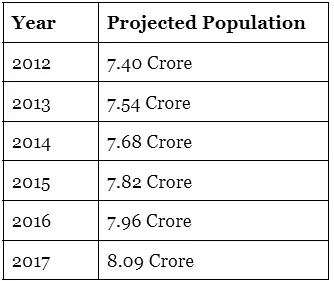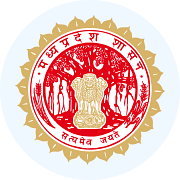Madhya Pradesh - Populations | Course for MPPSC Preparation - MPPSC (Madhya Pradesh) PDF Download
Population of Madhya Pradesh
Madhya Pradesh is large state in central India located in the geographic heart of India, between latitude 21.2°N-26.87°N and longitude 74°02′-82°49′ E, retains landmarks from eras throughout Indian history.Nicknamed the “heart of India” due to itsgeographical location in India. The state is the second- largest in the country by area. With over 75 million inhabitants, it is the 5thlargest state in India by population. It borders the state of Uttar Pradesh in the northeast, Chhattisgarh to the southeast, Maharastra to the south, Rajasthan to the northwest and Gujarat to the west. The state is fully landlocked. Total area of state is 308,252 km2.
As per details from Census 2011, Madhya Pradesh has population of 7.27 Crores, an increase from 6.03Crore in 2001.Density of state is 236 per sq km which is lower than national average 382 per sq km.The population growth in this decade was 20.35 percent. Total population of Madhya Pradesh as per 2011 census is 72,626,809 of which male and female are 37,612,306 and 35,014,503 respectively. In 2001, total population was 60,348,023 in which males were 31,443,652 while females were 28,904,371. The population of Madhya Pradesh forms 6.00 % of India in 2011 while the figure was 5.87 percent in 2001.
Religious share of population
Hinduism is majority religion in state of Madhya Pradesh with 90.89 % followers. Islam is second most popular religion in state with approximately 6.57 % followers; Christinity is followed by 0.29 %, Jainism by 0.78 %, Sikhism by 0.21 % and Buddhism by 0.21 %. Around 0.83 % stated ‘Other Religion’, approximately 0.13 % stated ‘No Particular Religion’. During last decade population of Hindu has decreased while population of Muslim and Christian has increased.

Rural and urban distribution of population (2011 Census):
Out of total population, 27.63% people live in urban regions. The total figure of population living in urban areas is 20,069,405 of which 10,462,918 are males and while remaining 9,606,487 are females. The urban population in the last 10 years has increased by 27.63 percent. While around 72.37 percent live in the villages of rural areas. In actual numbers, males and females were 27,149,388 and 25,408,016 respectively. Total population of rural areas of Madhya Pradesh state was 52,557,404. The population growth rate recorded for this decade (2001-2011) was 72.37%.
Projection of future Population Of Madhya Pradesh in 2017 on the basis of likely Population Growth Rate.

Sex Ratio in Madhya Pradesh is 931 i.e. for each 1000 male, which is below national average of 940 as per census 2011.Sex ratio in urban regions of State was 918 females per 1000 males. For child (0-6) sex ratio the figure for urban region stood at 901 girls per 1000 boys. Total children (0-6 age) living in urban areas of Madhya Pradesh were 2,483,664. Of total population in urban region, 12.38 % were children (0-6).While female sex ratio in rural population per 1000 males was 936 while same for the child (0-6 age) was 923 girls per 1000 boys.
In Madhya Pradesh, Child population forms 15.84 percent[, 8,325,731 children (0-6) ]of total rural population. Literacy rate in Madhya Pradesh was 63.94% according to 2011 census; of that, male literacy stands at 78.73 percent while female literacy is at 59.24 percent. Average Literacy rate in state for Urban regions was 82.85 percent in which males were 88.67% literate while female literacy stood at 69.46%. Total literates in urban region of Madhya Pradesh were 14,569,183. While In rural areas, literacy rate for males and female stood at 74.74 % and 48.49 %. Average literacy rate in Madhya Pradesh for rural areas was 63.94 percent. Total literates in rural areas were 28,281,986.
Most Populations region Madya Pradesh (2011)

Summary of demography in Madhya Pradesh

|
67 videos|98 docs
|

|
Explore Courses for MPPSC (Madhya Pradesh) exam
|

|
















